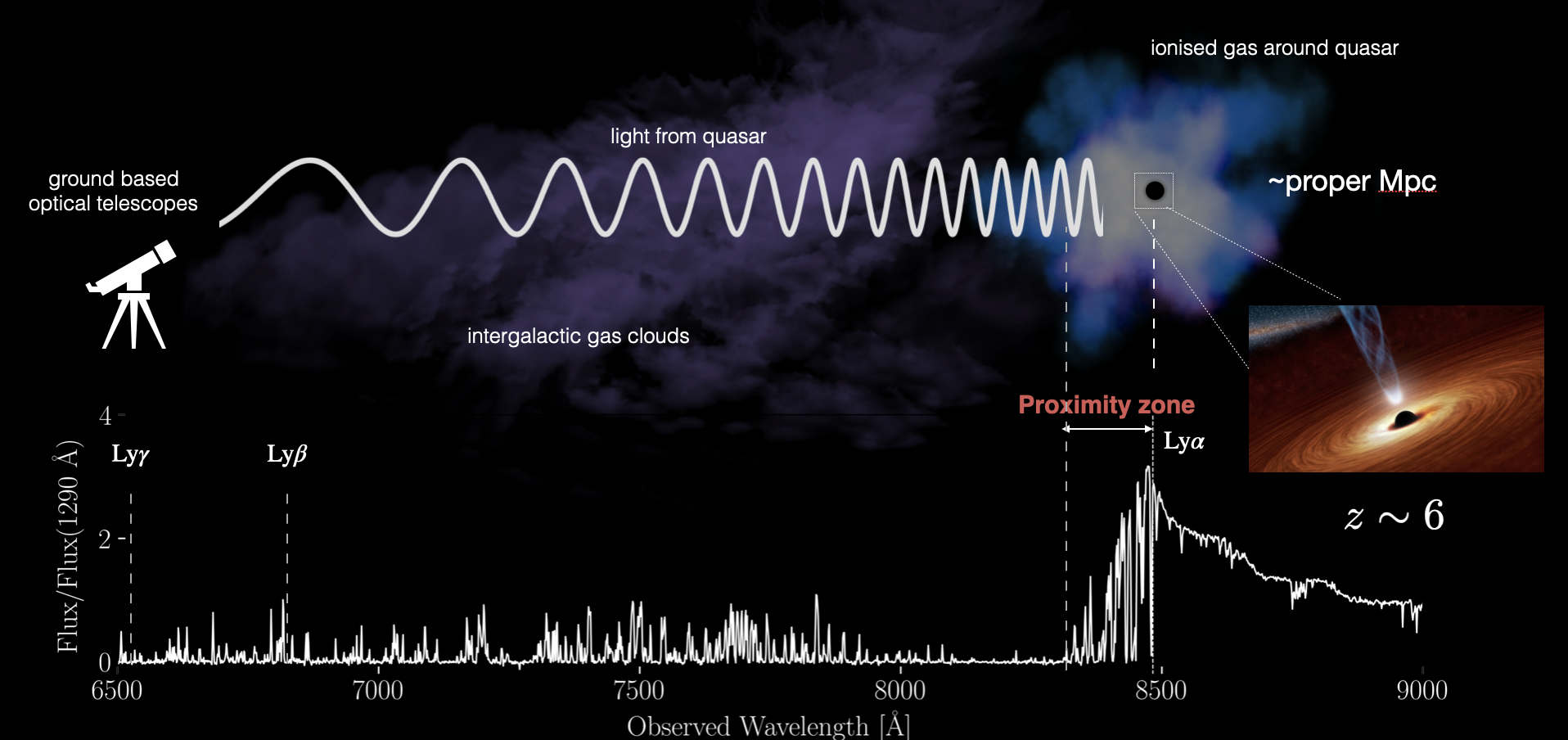Research in Extragalactic Astrophysics and Cosmology
Quasars are the brightest astrophysical sources in the Universe, powered by supermassive black holes. Several quasars have been observed as far as ~13 billion years back in time, having central supermassive black holes billion times more massive than the Sun. These quasars also act as a backlight, allowing us to look through the intergalactic medium between us and the quasar. That being so, what can we learn about the intergalactic medium and the cosmological model that led to it, from quasars? How did the supermassive black holes of quasars grow so massive within only a billion years after Big Bang?
I use simulations and observations of quasar spectra across several redshifts to probe answers to the above questions. I’m a member of the XQR-30, EREBUS-JWST collaborations for observing and studying high-redshift quasars, as well as the Dark Energy Spectroscopic Instrument (DESI) collaboration.
Quasar Proximity Zones in the Epoch of Reionization

The proximity zones of quasars with redshifts z>6 are not only unique probes of the growth of their central supermassive black holes (SMBHs), but also the only parts of the Universe at these redshifts where the cosmological small-scale structure can be measured. In my work, we investigated SMBH growth and the last stages of reionization through new simulations and observations of quasar proximity zones around z∼6. We utilized high-dynamic range cosmological hydrodynamical radiative transfer simulations with a late reionization history consistent with several post-reionization observables. By post-processing this simulation with a one-dimensional radiative transfer model, we analyze quasar proximity zones within an inhomogeneously reionized intergalactic medium at redshift z~6.
In Satyavolu et al. 2023a, we show that the residual neutral hydrogen islands at z~6 reduce quasar proximity zone sizes by up to 30%, with a more significant effect at higher redshifts. We also study the impact of quasar variability on proximity zone sizes using a toy model. Our comparison with observations suggests that quasars have a short duty cycle of f∼0.1 and an episodic lifetime of ~1 Myr. We further show that reconciling such variability with SMBH masses requires the black hole to continue to grow and accrete during its obscured phase. The consequent obscured fractions of ≳ 0.7 or higher are consistent with low-redshift measurements and models of black hole accretion, and will also be tested with our upcoming observations using JWST.
In Satyavolu et al. 2023b, we present 22 new measurements of proximity zones for quasars with redshifts between 5.8 and 6.6, utilizing the expanded XQR-30 sample of high-resolution, high-SNR quasarspectra. Our inferred proximityzone sizes range from 2to7physicalMpc,with typical uncertainties below 0.5 physical Mpc, which, for the first time, also includes uncertainty in the quasar continuum. With this,we increase the total number of proximity zone measurements in the late stages of cosmic reionization to 87. The catalog of all these measurements can be downloaded here.
In Satyavolu et al. 2024, we use the above simulations of quasar proximity zones to model their Lyman continuum (LyC) spectra, using which the mean free path (MFP) of hydrogen ionizing photons has been directly measured. We critically assess the analytic models used in previous measurements of the MFP for potential biases from quasar environments,their lifetimes and incomplete reionization around quasar proximity zones. We show that the bias from overdensities and patchiness in reionization around quasars is<25%,and the bias from quasar lifetimes is<10% at z∼6. Further,we develop a new technique to directly measure the MFP by fitting our model stacks to the observed LyC stack. Our meanfreepath measurement is 1.49+0.47−0.52 pMpc at z=6,reconciling both direct and indirect measurements in the literature.
